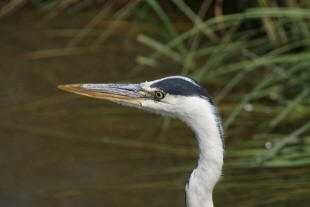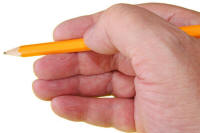Form, function, meaning

To understand a little about this area, it's necessary to distinguish between two basic forms of language analysis:
Can you make a stab at the difference? Click here for an answer.
- Formal theories of language are concerned with defining the different elements of the language (verbs, nouns etc.) in a way that explains how they operate with each other. A good deal of the language analysis on this site takes this approach.
- Functional approaches start from the understanding that language is primarily a tool for getting meaning across and that it is best analysed by looking at the functions bits of the language actually perform.
Examples may help.
In everyday life, away from the analysis of language, we are
actually more interested in the function of things than the labels
we put on them. For example, when faced with something that
looks like this:

we would normally ask something
like
Where does that door lead?
rather than
What's that?
when we hope for an answer such as
To the garden
In fact, the question What's that? when referring to a door is likely to raise an
eyebrow.
In this
case, asking
What's that?
would probably elicit:
What do you think it is?
On the other hand, when faced with:

then the question:
What's that?
is more legitimate and the answer you are likely to get is more
informative. It might be something like:
I'm not sure. It looks like an early
printing press or something.
In the classroom, especially with learners at lower levels,
teachers can often be trapped into asking questions such as:

What's this?
expecting an answer:
It's a pencil
which is, of course, not an example of real communication at
all because, unless one is talking to quite unusual people, it is
clear to everyone what the thing in question is and all the teacher
is really asking is:
Do you know the name for this in English?
and, if that really is the question, learners may be forgiven
for asking:
Then why didn't you ask me that question?
It may also be the case that the teacher is encouraging the
learner to demonstrate that she can use the phrase It's
and follow it with a suitable determiner and noun. That is a reasonable
focus on form but the exchange is still not anything like real
communication.
We can, therefore analyse any piece of language two ways. Take, for example, something said such as:
My house is on the corner
We can analyse that two ways:
- The formal way:
We have 6 words divided into three parts, like this:- my + house = the subject of the sentence, made up from a possessive determiner (my) + a simple noun (house)
- is = the verb which links the first two words to the rest of the sentence
- on + the + corner = a phrase telling us where something is, made up from on (a preposition) + the (an article) + corner (a noun)
- The functional way:
We have a simple utterance of six words and it might mean:- Please stop there and let me out (passenger to driver)
- This will help you to find my house (giving instructions)
- My house has a bigger garden than most of them in my street (explaining a fact)
This simple sentence might mean a number of other things depending on who is talking to whom, where they are and what they need to communicate.
 |
The 1970s |
Functional approaches to teaching the language came into vogue in the 1970s and have remained to the fore ever since. More recently, there has been something of a resurgence of interest in combining formal approaches (understanding and learning structure) with communicative approaches (learning to get things done in the language). Here's a quotation from a leading theorist in the field:
... language learning is essentially learning how grammar
functions in the achievement of meaning and it is a mistake to
suppose otherwise.
.... A communicative approach does not involve the rejection of
grammar. On the contrary, it involves a recognition of its central
mediating role in the use of and learning of language.
Widdowson (1990: 97/8)
The moral is that our learners need both types of information:
formal, linguistic competence to make structurally
correct language and communicative competence to
use the language appropriately.
Ideally, many believe, lessons should combine both approaches so that learners are
confident that they are getting the language right and able to see what
communicative ends the language serves.
 |
One form, many functions |
| a pot, a cup, a vase or a jar? |
One form may
have a number of functions.
Here are some examples.
| This language ... | ... could mean |
| The professor is writing a book | He is writing a book right this minute He is writing a book at the present time but may not be actually writing now He has arranged to write a book in the future |
| He should be there | He is obliged to be there I deduce that he is there He is advised to be there |
| It's cold in here | Please shut the window Please turn on the heating This is the reason I'm getting my coat |
| The bank is over there | That's where you can get some money That's where you can go fishing |
| convict | A noun: convict: a
person in prison A verb: convict: to find someone guilty) |
You can see from these examples that one form can have more than one meaning. The form can be:
- grammatical (a tense such as the present progressive)
- structural (the functions of the modal auxiliary verb should)
- pragmatic (the intended meaning behind saying It's cold in here)
- semantic (the meaning of bank)
- phonemic (the pronunciation of convict)
 |
Understanding |
If this is true, how on earth do people ever understand each other?
Well, how do they?
Think for a minute and then
see the answer.
- Contextual information
- If we have just spoken about money or fishing, I know what you mean when you refer to a bank.
- Shared knowledge
- If you and I know that the professor is currently lecturing, we both know that you can't mean he is writing a book right now.
How many functions are there?

Lots. However, it's quite easy to find lists which include
items such as
giving / getting permission
asking for and giving
factual information
apologising and accepting apologies
expressing
hopes and wishes
and so on.
Two key publications are from the Council of Europe and are available on
the web:
Waystage 1990 by Van Ek and Trim
Threshold 1990 by Van Ek and Trim
Waystage contains a long list of functions and notions for lower levels
and Threshold does the same for more advanced learners.
If you want a manageable list of 68 basic functions, there is one in
the introduction to functions
(new tab).
 |
Adjacency pairs |
Functions often come in pairs, because one function often requires
its counterpart(s). For example, asking for someone's name is a
useful function to control but less so if you don't know how to respond
by introducing yourself.
Here are some more adjacency pairs with
examples:
| apologising | accepting or rejecting apologies |
| I'm awfully
sorry Excuse me! Sorry! |
That's OK Not just now No you aren't |
| asking for permission | granting or denying permission |
| May I see you
for a minute? Can I ask a question? Will you let me help? |
Yes, of course Wait till I have finished No |
| asking directions | giving directions |
| Can you tell me
where the station is? Is this the right way to the beach? |
Yes, it's at the end of the next
road on the left I don't know |
and, of course, it makes sense to teach and practise them together. There's not much point in being able to ask for permission three different ways if you are unlikely to understand the response.
 |
Alternative responses |
You may also have noticed that many functions have alternate responses:
- positive: the outcome the hearer wants
Can you help me with this?
Yes, of course! - negative: the outcome the hearer does not want
Can you help me with this?
Sorry, no. - called
temporising: neither positive not negative but putting off the
response
Can you help me with this?
Not right now.
Learners need, of course, to be able to use all three.
 |
One function, many forms |
The other side of the coin is that we can use a number of forms to realise,
i.e. perform,
the same function. If I want to advise you, I can say, e.g.:
You
should see a doctor
You ought to get to the doctor
Do you think it wouldn't be a good idea to see a doctor?
etc.
Here's another set of examples.
| This function ... | ... could be achieved by ... |
| I want to tell you what he is doing sometimes but not now | He is writing a book He is engaged in writing a book He works on his book most mornings |
| I want to tell you what I've deduced | He should be there He must have arrived I'm sure he's got there by now |
| I want you to close the window | Please shut the window It's cold in here Do you think we could have the window shut? |
| I want to direct you to the bank | The bank is over there There's the bank It's over the road |
| He's in prison | He's a
convict He was convicted He's been banged up He was given a custodial sentence |
 |
Choosing the form |
If this is true, how on earth do we choose the right
form to realise the function?
Well, how do we?
Think for a minute
and then
see the answer.
- Intention
- Do I want to be polite, rude, deferential, explicit, vague etc.?
I can choose appropriately from:
Open the damn window!
Please open the window
I wonder if you would mind if we had the window open
Do you think we could let some air in?
etc. - Context and setting
- How much shared information is there?
If we are standing opposite the bank, I can simply point and say
There it is.
If I know you know something of the area, I can say
It's near the pub on the corner of the park.
If you are a complete stranger, I'll have to be much more explicit and use something like
Go straight along the High Street until you see Waterstone's on your left. Take the first right after that and then you'll see the bank at the end of the street. - Relationships and roles
- If one party is more powerful than the other (in this
setting) then different language is employed.
Asking someone to sit down could take the form of
Please sit there
Sit, boy!
I wonder if I could ask you to sit here
or whatever. - The medium
- Am I speaking or writing?
If I'm writing, is it an email or a letter?
Is this a formal lecture or a chat?
Things like this will affect the kind of language I choose.
Will I start with, Dear sir,?
Do I need to introduce myself?
etc.
 |
Teaching implications |
Think what these might be. Try to find an implication for each of the four factors and then compare your list.
- Intention:
We need to be clear about what certain forms say about the purposes of the user. We can only introduce and practise language successfully if the learners are aware of what they want to do with the language and how they want to appear. - Context and setting:
You can't learn, use or understand language in a vacuum. Formal grammar exercises and drilling have their place, allegedly, but when introducing or practising language forms we need to set a clear context and the learners also need to know where and when they are using the target language. - Relationships and roles:
In the classroom, relationships between the teacher and the learners and between learners are often informal and equal. Outside, in the real world, that's often not the case so we need to set up scenarios in which learners can practise choosing the appropriate language. - The medium:
If we are practising either speaking or writing, we need to have the audience and the speaker / writer's role in mind at all times.
References:
Van Ek, J and Trim, J, Waystage 1990, Cambridge: Cambridge
University Press
Van Ek, J and Trim, J, Threshold 1990, Cambridge: Cambridge
University Press
Widdowson, H, 1990, Aspects of Language teaching, Oxford: Oxford
University Press
